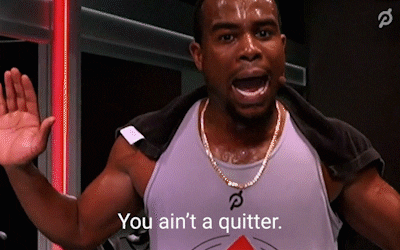1. Make the call about the prospect, not about you.
The reason for the call must be based on providing the prospect with information or insight they will find of value.
This is not your time to shine and talk about your ideas, or your accomplishments. The prospect must be the focus of this call. What are their needs? What problems do they need help solving?
When you spend less time talking, and more time listening, you’re able to cultivate a conversation. You’ll walk away with valuable insights to use on the next call you have with them.
2. Speak with energy and believe in yourself.
If you don’t believe in yourself and speak with confidence and energy, why should you expect the prospect to pay attention?
Your attitude going into the call has a huge effect on the results you’ll get coming out of the call. A bad attitude can kill a call before it’s even started.
3. Keep your voicemails short.
You voicemail should never be more than 12-14 seconds. That means you need to know ahead of time what you’re going to say.
Do not allow the prospect to make a decision without you solely based on what you say in the voicemail. There’s no need to recite your entire pitch.
Keep it short, keep it simple, and leave them with a nugget for the next time you call back. Because we both know: They’re not going to call you back.
4. Be prepared.
Typically, calls can go one of 4 ways — a gatekeeper answers, you reach a main menu, it rolls to voicemail or the prospect you want to reach answers. Each one requires a different type of response from you. Be prepared no matter which way it goes.
If you’re lucky and do reach the prospect, I like to have a few statements to share, and a few questiont to ask.
I also want to go into the call with a clear CTA, Call to Action. What do I want the prospect to do as a result of my call?
Read more about what makes a great prospecting call.
5. Use a high-quality headset.
We are more effective in our communication when we speak with our hands even when the other person can’t see us. Wearing a headset will allow you to do that.
I also believe this helps to get your personality across, and when you show confidence, you build trust with the customer.
6. Use the day wisely.
Many prospects are best reached before 8 AM or after 5 PM. Experiment with different times to learn what types of prospects are most likely to respond at what time.
Using your time wisely also means not wasting time with the wrong prospects. Think about who your ideal customer is, and create a profile of that prospect. If who you’re calling doesn’t fit at least 60% of that profile, hang up the phone. You’ll only waste your precious time.
Read more about what makes a good prospect.
7. One call isn’t going to cut it.
Be prepared to call the same prospect a number of times to finally be able to breakthrough. A strategy I like is 6 contacts in a month. If after a month I’m not successful, I will then back off for 60 to 90 days and then repeat the process.
8. Keep detailed records.
Always record the day and time you make a call and what you stated in your voicemail.
Never leave the same voicemail twice and never call again at the same time of day or day of the week.
You will increase your odds of reaching the person by trying different days and different times.
9. Try the top of the hour.
Calling at the top of the hour is a very effective way to reach busy people.
Most meetings start at the top of the hour, which means the one time you might be able to catch the person is just before a meeting starts.
10. Never give up.
It’s easy to think the telephone isn’t effective and that using email or even social media is the way to go. The only reason people think that is because they are not willing to put in the effort and time to make telephone prospecting a part of their overall prospecting plan.
Copyright 2015, Mark Hunter “The Sales Hunter.” Sales Motivation Blog. Mark Hunter is the author of High-Profit Selling: Win the Sale Without Compromising on Price.







